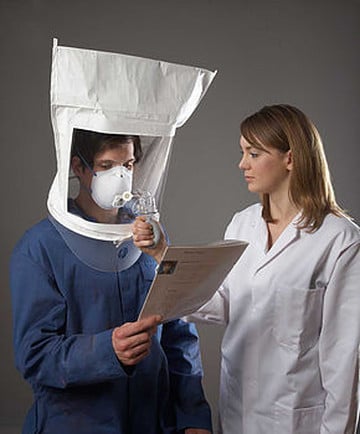What is a Respirator?
A respirator is a Personal Protective Equipment (PPE) device designed to protect workers from inhaling harmful atmospheres, including respirable crystalline silica, asbestos, welding fumes, and dust particles. A good fitting respirator will seal to the skin as protection is only provided when air passes through the respirator’s filter. If the respirator isn't sealed, the air will go around the respirator, leaving the worker vulnerable to harmful airborne particles.
With this in mind, it is important to test the level of protection offered by a respirator on each user to ensure optimal protection, and there is a number of ways to do this.
User Seal Check
It is important that before each use of the respirator, the wearer performs a seal check to make sure that the respirator is in working order. There are two quick and easy ways to perform a seal check, using either;
-
Positive pressure – by either blocking the exhalation valve or covering the respirator surface and exhaling. If the air is not leaking around the respirator there will be a slight pressure build up.
-
Negative pressure – by blocking the intake valves or covering the respirator surface and inhaling. The seal is in working order if no air enters the respirator.
Respirator Fit Test
Respirators must undergo fit testing to ensure they are protecting the wearer sufficiently from respirable environmental hazards in the workplace. A respirator fit test determines whether the respirator is able to keep its seal even when the worker is moving about while conducting their tasks. Fit testing is obligatory for all tight-fitting facepieces, including positive pressure masks, filtering facepieces and both half and full facepieces.
Annual assessments must be conducted, or as often as required if a change in the wearer has occurred (such as significant weight loss or dental work) or a new type, size or model is being used.
There are two types of tests that can determine whether a respirator has formed an adequate seal; qualitative and quantitative.
|
Qualitative Fit Test
A qualitative fit test relies on the worker’s ability to detect the presence of a certain substance through taste or smell through their respirator. Accepted test agents include isoamyl acetate (banana smell) for use with organic vapor cartridges, and a saccharin fit test (sweet taste) or a Bixtrex fit test (bitter taste) for use with particulate filters of any class. If the wearer has not detected the solution after a series of movements, breathing, and talking, the respirator fit passes the test.
Quantitative Fit Test
A quantitative fit test uses a machine to detect the numeral amount of leakage into the respirator. A hose will attach the machine to a probe on the face piece. A PortaCount Pro is an ambient particle counting device used in quantitative fit testing to produce Fit Factor results – a measure of how well-sealed a respirator is to the wearer’s face. This is expressed as a ratio, for example, a fit factor of 100
means that the filtered air inside of the respirator is 100 times cleaner than the air outside of the respirator. In terms of the particle size range that the PortaCount Pro can measure, the 50% cut off is 0.02 micrometres (µm), meaning half of the 0.02 particles will be counted and half will not be. Up to 100% of the particles at the size of 0.04 µm will be counted.
A PortaCount Pro can be used with a PAPR so long as the mask is in negative-pressure mode. It is also important to note that no smoking is permitted within 60 minutes before a fit test as exhaled particles from the smoke will be counted and a lower fit factor will be recorded.
|
 |
Respirator Fit Testing Services
It is important that the person conducting the fit test is well trained in testing as the results can be greatly affected by the competency of the fit tester. If the fit test is not conducted correctly, the wearer of the respirator may be at risk of exposure to contaminants.
Whether you’re in need of a full face respirator fit test, half mask fit test, or require testing for PAPRs, filtering facepieces or any other type of respirator, ATOM Safety offer fit test programs in select locations to conduct fit testing, ensuring the accurate procedure so that your team receive the best possible protection from respirator usage. A respirator fit test report is issued upon passing the test which includes details of the respirator and test, as well as the overall fit factor. The ATOM Safety team can also advise which type of respirators are best for your workplace, with extensive knowledge on a wide variety of styles from leading brands.
If you would like to find out more information about fit testing requirements, contact the team at ATOM Safety.
